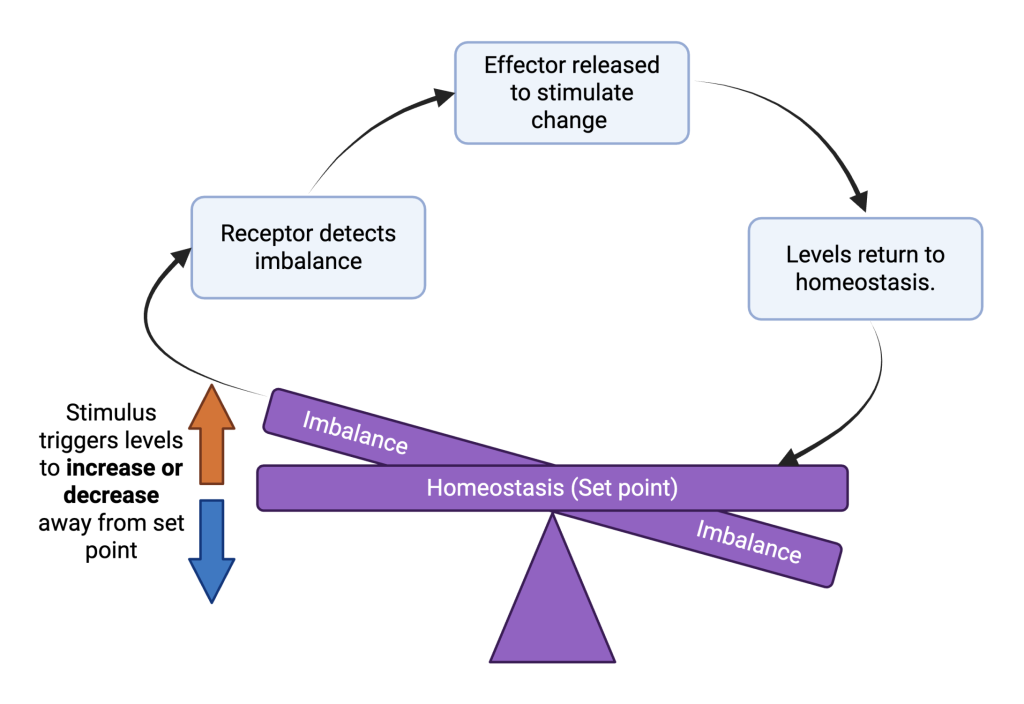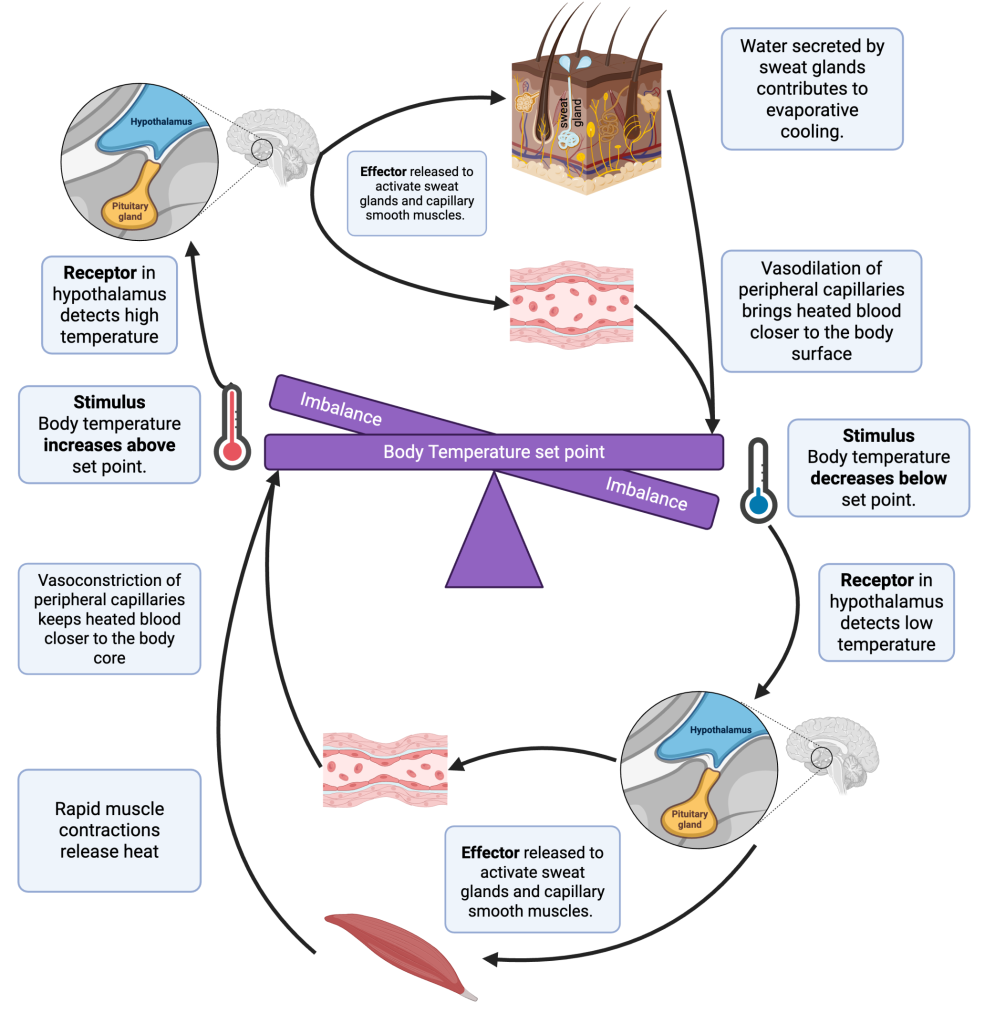11.1 Introduction to Homeostasis
Malia Hoey
Learning Objectives
By the end of this section, you will be able to do the following:
- Define homeostasis.
- Describe the factors affecting homeostasis.
- Discuss negative and positive feedback mechanisms used in homeostasis.
- Explain how set points can be adjusted and identify examples in homeostatic systems.
Animal organs and organ systems constantly adjust to internal and external changes through a process called homeostasis (“steady state”). This fundamental process is vital for an organism’s survival and appropriate functioning. These changes might concern the level of glucose or calcium in the blood, or shifts in external temperatures. Homeostasis refers to the maintenance of dynamic equilibrium in the body. It is dynamic because it is constantly adjusting to the changes that the body’s systems encounter. It is equilibrium because body functions stay within specific ranges. Even an animal that appears inactive is continuously maintaining this homeostatic equilibrium.
Homeostatic Processes
The aim of homeostasis is the maintenance of equilibrium around a point or value called a set point. While there are normal fluctuations from the set point, the body’s systems will typically attempt to return to this point. A change in the internal or external environment is called a stimulus, which is detected by a receptor. The response of the system is to adjust the altered condition toward the set point. For example, if the body becomes too warm, adjustments are made to cool the animal. If the blood’s glucose rises after meal consumption, adjustments are made to lower blood glucose levels by transporting the nutrients into tissues or storing it for later use.
Control of Homeostasis
The adjustments required for homeostasis are managed through physiological control mechanisms, primarily feedback loops. Most homeostatic processes rely on negative feedback loops, which counteract changes to restore balance. In contrast, positive feedback loops amplify the initial change, actually pushing the system further away from the set point.
The receptor senses the change in the environment and initiates a signal in response to the disruption. This signal leads to the activation of an effector, which may be a muscle (that contracts or relaxes) or a gland (which secretes substances). In mammals, many of these responses are coordinated by the hypothalamus, a region of the brain that plays a primary role in regulating homeostasis. The hypothalamus works closely with the nervous system, which uses rapid electrical signals, and the endocrine system, which relies on slower but longer-lasting hormonal signals.

Negative Feedback Mechanisms
In a negative feedback loop, a homeostatic process functions to reverse the direction of the initial change in a regulated variable. When a stimulus (a deviation from the set point) is detected by a receptor, effectors are signaled to produce a response that directly counteracts the original stimulus, bringing the regulated variable back towards its set point. In other words, if a level is too high, the body acts to lower it; if a level is too low, the body acts to raise it. This reversal of the initial change is what we refer to as negative feedback.
A classic example of a negative feedback loop is the regulation of body temperature in mammals. When temperature rises above the set point, receptors in the hypothalamus detect this increase and trigger effectors such as sweat glands and blood vessels. Sweating and vasodilation (widening of blood vessels) promote heat loss, helping lower body temperature.
Conversely, when temperature drops below the set point, the hypothalamus activates effectors like skeletal muscles and blood vessels to conserve and generate heat. Shivering (rapid muscle contractions) and vasoconstriction (narrowing of skin blood vessels) work to raise body temperature back toward normal. In both cases, the system’s response opposes the initial change, demonstrating how negative feedback maintains stable internal conditions.

Positive Feedback Loop
In contrast, a positive feedback loop maintains the direction of the stimulus, possibly accelerating it. Few examples of positive feedback loops exist in animal bodies, but one is found in the cascade of chemical reactions that result in blood clotting, or coagulation. As one clotting factor is activated, it activates the next factor in sequence until a fibrin clot is achieved. The direction is maintained, not changed, so this is positive feedback.
Set Point
It is possible to adjust a system’s set point. When this occurs, the feedback loop continues to function but now works to maintain the new set point.
An example of this is blood pressure: over time, the normal set point for blood pressure can increase due to sustained elevated blood pressure levels. The body then perceives this higher pressure as normal and no longer attempts to return to the initial, lower set point. This results in the maintenance of elevated blood pressure, which can have harmful effects on the body. Medication can help lower blood pressure and reset the system’s set point to a healthier level. This process is known as alteration of the set point in a feedback loop.
Changes can also occur across multiple organ systems to maintain a set point in another system. This process, called acclimatization, is seen when animals migrate to higher altitudes with lower oxygen saturation. To adjust, the body increases red blood cell production to ensure adequate oxygen delivery to tissues. Another example is seasonal changes in animal coats: a heavier coat in winter helps retain heat, while a lighter coat in summer aids in preventing body temperature from rising to harmful levels.
Video 11.1.1. Feedback Loops by Johnny Clore
Practice Questions
In the question below, you will be presented with a new homeostasis scenario. Before you answer the series of questions, we recommend that you draw out a diagram similar to the ones in Figure 11.1 and Figure 11.2.
Glossary
homeostasis
how an organism’s body system regulates itself towards a relatively stable equilibrium.
equilibrium
state in which opposing forces or influences are balanced
feedback loop
mechanism by which a system self-regulates as outputs of a system are routed back as inputs
negative feedback loop
homeostatic function that seeks to reverse the initial change of the stimulus.
positive feedback loop
feedback loop that maintains the direction of the stimulus
stimulus (sometimes referred to as signal)
detectable change in an organism’s environment (physical or chemical) that results in functional activity
receptor
structure in the body that detects a stimulus and guides the system to adjust the altered condition
effector
structure in the body (often a muscle, gland, or a blood vessel) that fixes the disruption from the stimulus
set point
physiological value around which the normal range fluctuates
Figure Descriptions
Figure 11.1.1. The image illustrates a homeostasis feedback loop. At the center, a purple seesaw labeled “Homeostasis (Set point)” is shown with one side tilted to indicate “Imbalance.” On the left, an orange upward arrow and a blue downward arrow represent a stimulus triggering levels to increase or decrease, moving away from the set point. This leads to the label “Receptor detects imbalance,” which points to “Effector released to stimulate change” at the top. An arrow leads to “Levels return to homeostasis.” The cycle continues with an arrow pointing back to “Receptor detects imbalance,” completing the loop. [Return to Figure 11.1.1]
Figure 11.1.2. This diagram illustrates the negative feedback loop that regulates body temperature homeostasis. At the center is a purple balance beam labeled “Body Temperature set point,” which tilts toward “Imbalance” on both ends to indicate deviation from equilibrium. On the left side of the diagram, the process begins with the label “Stimulus: Body temperature increases above set point,” accompanied by an upward-pointing red thermometer icon. Next, the label “Receptor in hypothalamus detects high temperature” appears next to an image of the brain with the hypothalamus and pituitary gland highlighted. Arrows indicate that an “Effector released to activate sweat glands and capillary smooth muscles,” leading to two physiological responses: “Water secreted by sweat glands contributes to evaporative cooling” and “Vasodilation of peripheral capillaries brings heated blood closer to the body surface.” On the right side of the diagram, the opposite process is shown. It begins with “Stimulus: Body temperature decreases below set point,” accompanied by a downward-pointing blue thermometer icon. A “Receptor in hypothalamus detects low temperature” triggers an “Effector released to activate sweat glands and capillary smooth muscles.” This results in “Rapid muscle contractions release heat” (illustrated by a red muscle) and “Vasoconstriction of peripheral capillaries keeps heated blood closer to the body core.” Arrows cycle between stimuli, receptors, effectors, and resulting changes to show how the body works to oppose imbalances and return to the set point. The entire system models how the hypothalamus helps maintain thermal equilibrium through a continuous feedback loop. [Return to Figure 11.1.2]
Licenses and Attributions
“11.1 Introduction to Homeostasis” is adapted from “33.3 Homeostasis” by Mary Ann Clark, Matthew Douglas, and Jung Choi for OpenStax Biology 2e under CC-BY 4.0. “11.1 Introduction to Homeostasis” is licensed under CC-BY-NC 4.0.
Media Attributions
- 1A.B-Homeostasis-General © Christelle Sabatier is licensed under a CC BY-NC (Attribution NonCommercial) license
- 1A.B-Temperature-Homeostasis © Christelle Sabatier is licensed under a CC BY-NC (Attribution NonCommercial) license
How an organism’s body system regulates itself towards a relatively stable equilibrium.
A state in which opposing forces or influences are balanced.
Physiological value around which the normal range fluctuates.
Detectable change in an organism’s environment(physical or chemical) that results in functional activity.
A mechanism which a system self-regulates as outputs of a system are routed back as inputs.
A homeostatic function that seeks to reverse the initial change of the stimulus.
A feedback loop that maintains the direction of the stimulus.
A structure in the body that detects the stimulus and guides the system to adjust the altered condition.
A structure in the body(often a muscle, gland, or a blood vessel) that fixes the disruption from the stimulus
